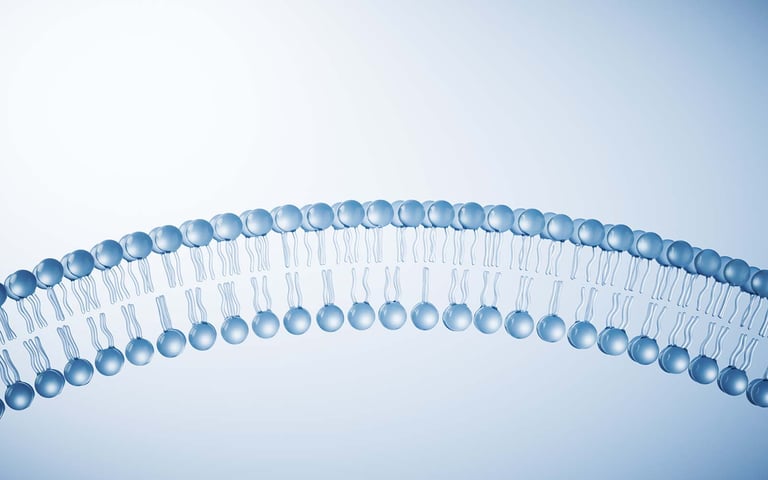
Detergents play an important role in inhibiting membrane-enveloped pathogens such as bacteria and viruses in industrial bioprocessing and in blood transfusion applications. The QCM-D technique is highly sensitive to characterize the interfacial activity of detergents and surfactants at solid-liquid interfaces. In this blog post, we present an example where the QCM-D technique was used to compare the potency and mechanism of action to disrupt lipid membranes of two different detergents.
Until recently, the membrane-disrupting Triton X-100 (TX-100) detergent was the most popular option for pathogen inhibition, however, its use is being phased out due to environmental concerns. There is intense interest in finding antimicrobial detergents to replace TX-100 but it is difficult to develop effective replacements due to the limitations of biological assays. Indeed, it is critical to not only determine whether a new detergent inhibits pathogens as well as TX-100 but to also evaluate how the detergent disrupts lipid membranes—a mechanistic question that QCM-D technology is uniquely capable of answering quickly in a cost-effective manner.
To mimic pathogenic membranes, a supported lipid bilayer (SLB) was first formed on silica-coated QCM-D sensor chips by using the bicelle method. Afterwards, different concentrations of TX-100 detergent or a proposed replacement detergent (SL-11W) were injected into the measurement chamber, and real-time changes in the mass and viscoelastic properties of the SLB platform were monitored. The maximum changes in the SLB properties during the detergent interaction process were quantified along with the final SLB properties after a buffer washing step. This measurement approach enabled determination of the minimum concentration at which each detergent caused membrane disruption in order to define their respective potencies as well as their corresponding speed and type of disruption such as membrane solubilization or binding.
It was identified that TX-100 causes rapid and irreversible membrane solubilization of the SLB platform at detergent concentrations down to 250 µM. By contrast, SL-11W only caused extensive membrane disruption at 2000 µM and higher detergent concentrations, and the effects occurred gradually and were fully reversible. The concentration-dependent QCM-D results indicated that the detergents were only active above their respective critical micelle concentration values, establishing that TX-100 is approximately 8 times more potent than SL-11W. Importantly, the QCM-D measurement outputs demonstrated that the two detergents have distinct mechanisms of membrane disruption and function differently (Figure 1). More specifically, TX-100 caused irreversible membrane solubilization whereas SL-11W caused transient, reversible membrane budding.

Figure 1: Membrane disruption efficiency of different antimicrobial detergents. A supported lipid bilayer (SLB) platform was fabricated on the sensor surface before Triton X-100 (TX-100) detergent or a replacement candidate (SL-11W) was added. TX-100 quickly caused membrane disruption and complete SLB solubilization whereas SL-11W caused large, temporary membrane morphological changes but not permanent membrane disruption.
The QCM-D approach provided direct experimental evidence that the two detergents exhibited different potencies and mechanisms of action to disrupt lipid membranes. Such insights can be important for validating detergent performance in order to find functionally equivalent detergents with similar inhibitory efficacies and biophysical mechanisms. While antimicrobial detergents are typically screened in terms of biological performance, typical biological assays are slow, costly, require high technical expertise and safety standards, and provide only limited mechanistic information. QCM-D technology addresses all of these shortcomings by providing a fast and affordable tool to unravel mechanistic information in conventional lab settings.
The QCM-D technique is highly sensitive to characterize the interfacial activity of detergents and surfactants at solid-liquid interfaces. In addition to lipid membrane platforms, the solubilizing effects of detergents to remove other types of particulates such as soil and oil from sensor surfaces can also be detected for cleaning applications. The real-time tracking capabilities are also able to unravel more complex biomacromolecular interaction processes such as membrane-peptide interactions related to anticancer and antiviral drug development.
Download the overview to learn more about how QCM-D can be used to analyze molecular interactions at surfaces and interfaces in biotechnology and biophysics.
This blog post was written in collaboration with Prof. Joshua A. Jackman, Associate Professor in the School of Chemical Engineering and the Biomedical Institute for Convergence at Sungkyunkwan University in South Korea and Director of the Translational Nanobioscience Research Center.
Learn best practices and step-by-step methods for accurate QCM-D coating thickness measurement on QSense sensors using QSense Omni.
Compared to QCM, QCM-D measures an additional parameter, and provides more information about the system under study.
Discover how QCM-D analysis reveals real-time etching dynamics, helping optimize cleaning processes and protect surfaces from unwanted damage.
Discover how QSense QCM-D helps tackle fouling challenges across industries
Discover how QCM-D enables real-time, label-free analysis of supported lipid membrane formation, structure, and dynamics for advanced research
Learn how QSense QCM-D analysis can reveal membrane fouling dynamics and optimize cleaning strategies for more efficient water treatment
Learn how QSense QCM-D helps detect and prevent surface-induced instabilities in biologics. Join our webinar for insights and practical examples.
Learn about the top QSense sensors for analyzing biopharmaceutical drug-surface interactions in the context of IV bags.
Learn about QCM-D, Quartz Crystal Microbalance with Dissipation monitoring - an analytical tool for surface interaction studies at the nanoscale.
